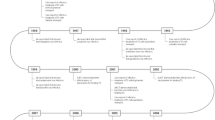Abstract
Tourette’s syndrome is a childhood-onset neuropsychiatric disorder characterized by motor and vocal tics that are chronic (duration of >1 year) (Kurlan N Engl J Med. 363:2332; Jankovic and Kurlan Mov Disord. 26:1149; Diagnostic and statistical manual of psychiatry. 4th ed.). Tics are commonly associated with obsessive–compulsive symptoms and disturbances of attention. In many children with Tourette’s syndrome, tics are mild and not disabling, and education about the condition with supportive counseling is sufficient. However, tics can be disabling by causing social embarrassment, school bullying, isolation, and sometimes conflict. Some tics are painful, and some can be self-injurious. When tics are disabling, tic-suppressing therapy is indicated which can be behavioral therapy and/or pharmacotherapy. Treatment of associated ADHD and OCD symptoms is also warranted when they are disabling.
Similar content being viewed by others
References
Kurlan R. Clinical practice: Tourette’s syndrome. N Engl J Med. 2010;363:2332.
Jankovic J, Kurlan R. Tourette syndrome: evolving concepts. Mov Disord. 2011;26:1149.
Diagnostic and statistical manual of psychiatry. 4th ed. rev. Washington, DC: American Psychiatric Association, 2000.
Scharf JM, Miller LL, Gauvin CA, et al. Population prevalence of Tourette syndrome: a systematic review and meta-analysis. Mov Disord. 2015;30:221.
RD F, DK F, Burd L, et al. An international perspective on Tourette syndrome: selected findings from 3,500 individuals in 22 countries. Dev Med Child Neurol. 2000;42:436.
Kwak C, Dat Vuong K, Jankovic J. Premonitory sensory phenomenon in Tourette’s syndrome. Mov Disord. 2003;18:1530.
Freeman RD, Zinner SH, Muller-Vahl KR, et al. Coprophenomena in Tourette syndrome. Dev Med Child Neurol. 2009;51:218–27.
Jankovic J. Tourette’s syndrome. N Engl J Med. 2001;345:1184–92.
Pauls DL, Leckman JF. The inheritance of Gilles de la Tourette’s syndrome and associated behaviors: evidence for autosomal dominant transmission. N Engl J Med. 1986;315:993–7.
Leckman JF, Zhang H, Vitale A, et al. Course of tic severity in Tourette syndrome:the first two decades. Pediatrics. 1998;102:14–9.
Piacentini J, Woods DW, Scahill L, et al. Behavior therapy for children with Tourette disorder :a randomized controlled trial. JAMA. 2010;303:1929–37.
Roessner V, Plessner K, Rothenberger A, Ludolph A, Rizzo R, Skov L, et al. European guidelines for Tourette syndrome and other tic disorders. Part II: pharmacological treatment. Eur Child Adolesc Psychiat. 2011;20(4):173–96.
Scahill L, Chappell PB, Kim YS, et al. A placebo-controlled study of guanfacine in the treatment of children with tic disorders and attention deficit hyperactivity disorder. Am J Psychiatry. 2001;158:1067–74.
Leckman JF, Hardin MT, Riddle MA, Stevenson J, Orf SI, Cohen DJ. Clonidine treatment of children with tic disorders and attention deficit hyperactivity disorder. Am J Psychiatry. 2001;158:1067–74.
Pringsheim T, Marras C. Pimozide for tics in Tourette’s syndrome. Cochrane Database Syst Rev 2009:CD006996.
Ross MS, Moldofsky H. A comparison of pimozide and haloperidol in the treatment of Gilles de la Tourette’s syndrome. Am J Psychiatry. 1978;135:585–7.
Dion Y, Annable L, Sandor P, et al. Resperidone in the treatment of Tourette syndrome: a double blind, placebo-controlled trial. J Clin Psychopharmacol. 2002;22:31–9.
Muller-Vahl KR, Krueger D. Does Tourette syndrome prevent tardive dyskinesia? Movment Disord. 2011;26(13):2442–3.
Porta M, Sassi M, Cavallazzi M, et al. Tourette’s syndrome and role of tetrabenazine: review and personal experience. Clin Drug Investig. 2008:443–59.
Jimenez-Shahed JJ, LW B. A randomized, double-blind, placebo-controlled study of topiramate in the treatment of Tourette syndrome. J Neurol NeurosurgPsychiatry. 2010;81:70–3.
Marras C, Andrews D, Sime E, Lang AE. Botulism toxin for simple motor tics: a randomized, double-blind, controlled clinical trial. Neurology. 2001;56:605.
Kwak CH, Hanna PA, Jankovic J. Botulinum toxin in the treatment of tics. Arch Neurol. 2000;57:1190.
Tourette’s Syndrome Study Group. Treatment of ADHD in children with tics: a randomized controlled trial. Neurology. 2002;58:527–36.
Nass R, Bressman S. Attention deficit hyperactivity disorder and Tourette syndrome: what’s the best treatment? Neurology. 2002;58:513.
Allen AJ, Kurlan RM, Gilbert DL, et al. Atomoxetine treatment in children and adolescents with ADHD and comorbid tic disorders. Neurology. 2005;65:1941–9.
Author information
Authors and Affiliations
Corresponding author
Ethics declarations
Conflict of Interest
Laura Duda and Gayatra Mainali declare that they have no conflict of interest.
Human and Animal Rights and Informed Consent
This article does not contain any studies with human or animal subjects performed by any of the authors.
Additional information
This article is part of the Topical Collection on Tourette’s Syndrome
Rights and permissions
About this article
Cite this article
Duda, L., Mainali, G. Pharmaceutical Interventions for Tourette’s Syndrome. Curr Dev Disord Rep 3, 213–216 (2016). https://doi.org/10.1007/s40474-016-0098-2
Published:
Issue Date:
DOI: https://doi.org/10.1007/s40474-016-0098-2




